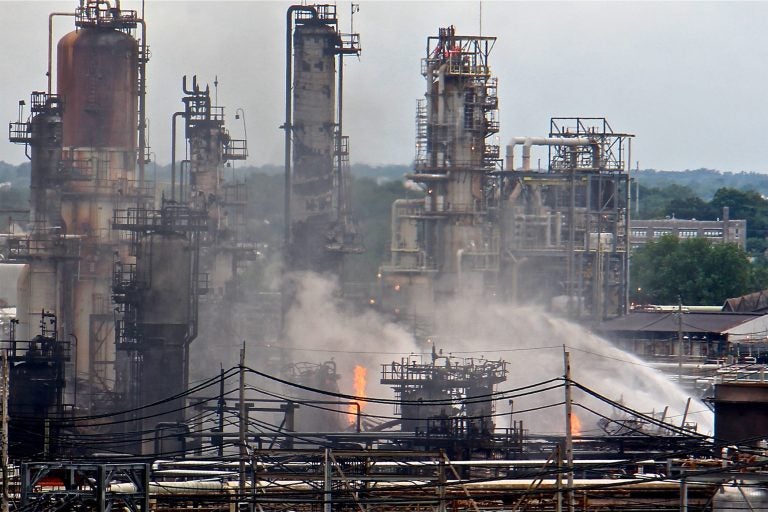Most of a dangerous toxic chemical at the PES refinery is now neutralized — but risk remains
A small amount of hydrofluoric acid is left to be dealt with in a 'complicated operation.'

A fire burns at the Philadelphia Energy Solutions refinery hours after a series of early morning explosions on June 21, 2019. (Emma Lee/WHYY)
The vast majority of a toxic chemical stored at the Philadelphia Energy Solutions refinery has been neutralized, according to Philadelphia Fire Commissioner Adam Thiel.
The chemical – hydrofluoric acid – posed a danger to workers and the surrounding community in the wake of the June 21 explosion and fire at the plant in South Philadelphia. But Thiel said risk remains, as a “much smaller amount” of HF that is mixed in with hydrocarbons still needs to be remediated, and that process is also risky.
Neutralizing about 340,000 pounds, or about 45,000 gallons, of the highly toxic hydrofluoric acid was a dangerous task and took almost a month to complete.
Workers had to don rubber suits in hot temperatures, and carefully add a base to the acid in such a way that it didn’t explode and leak into the surrounding neighborhoods.
Philadelphia Fire Commissioner Adam Thiel calls neutralizing the large volume of poisonous gas a milestone.
“We felt like the risk-benefit ratio on that was clearly towards going through this to neutralize the vast majority of the acid on site,” he said.
Hydrofluoric acid is one of the most poisonous industrial chemicals in use. Exposure can cause serious injury or death.
Refineries use it as a catalyst to create high-octane fuel, and it was an integral part of the unit that exploded at PES back in June.
The company’s own risk management plan, filed with the Environmental Protection Agency as a requirement under the Clean Air Act, describes a catastrophic worst-case scenario involving hydrofluoric acid. If 143,262 pounds of hydrogen fluoride were released over 10 minutes, a toxic cloud could travel for more than seven miles and affect more than a million people — including in schools, homes, hospitals, prisons, playgrounds and parks — and a wildlife sanctuary.
The chemical penetrates the skin and reacts with the calcium in bones. Swallowing just a small amount, or getting small splashes on the skin, can be fatal, according to the Centers for Disease Control and Prevention. In its gaseous state, the CDC says, low levels of hydrogen fluoride can irritate the eyes, nose and respiratory tract. Breathing it at high levels “can cause death from an irregular heartbeat or fluid buildup in the lungs.”
Officials have said no hydrofluoric acid was detected by air monitors after the explosion.
Thiel said the next phase of the process includes neutralizing a much smaller amount of the chemical that is currently mixed in with hydrocarbons.
“It is contained, it’s not exposed to the atmosphere,” he said. “Still, it’s a very complicated operation and it will take some time.”
Thiel would not say how much hydrofluoric acid remains. In the meantime, the department’s hazardous materials unit remains on site.
Officials had previously reported that the amount needed to be neutralized was 33,000 gallons. Thiel said that figure was inaccurate, and in fact, 340,000 pounds (which roughly equates to 45,000 gallons) of HF stored on-site posed a significant risk.
In the gaseous state, the volume is measured in pounds. When it becomes a liquid, it is measured in gallons. The neutralization process involves adding a base, which would turn the acid into a different, non-toxic liquid.
WHYY is your source for fact-based, in-depth journalism and information. As a nonprofit organization, we rely on financial support from readers like you. Please give today.





